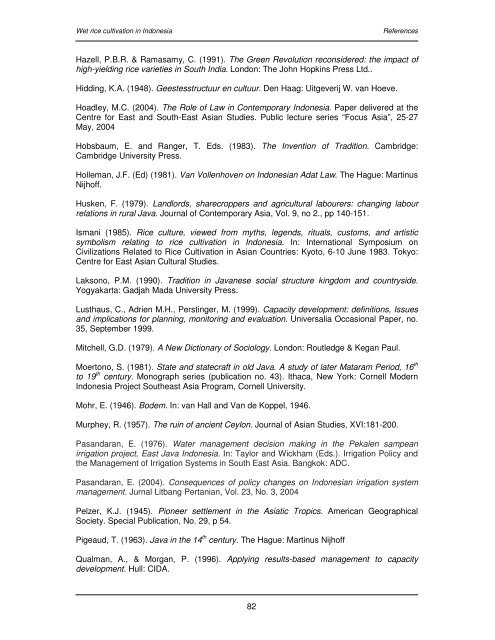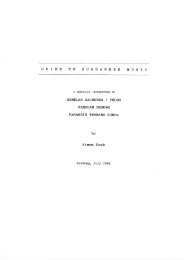Wet rice cultivation in Indonesia - Free EBooks Library
Wet rice cultivation in Indonesia - Free EBooks Library
Wet rice cultivation in Indonesia - Free EBooks Library
You also want an ePaper? Increase the reach of your titles
YUMPU automatically turns print PDFs into web optimized ePapers that Google loves.
<strong>Wet</strong> <strong>rice</strong> <strong>cultivation</strong> <strong>in</strong> <strong>Indonesia</strong> References<br />
Hazell, P.B.R. & Ramasamy, C. (1991). The Green Revolution reconsidered: the impact of<br />
high-yield<strong>in</strong>g <strong>rice</strong> varieties <strong>in</strong> South India. London: The John Hopk<strong>in</strong>s Press Ltd..<br />
Hidd<strong>in</strong>g, K.A. (1948). Geestesstructuur en cultuur. Den Haag: Uitgeverij W. van Hoeve.<br />
Hoadley, M.C. (2004). The Role of Law <strong>in</strong> Contemporary <strong>Indonesia</strong>. Paper delivered at the<br />
Centre for East and South-East Asian Studies. Public lecture series “Focus Asia”, 25-27<br />
May, 2004<br />
Hobsbaum, E. and Ranger, T. Eds. (1983). The Invention of Tradition. Cambridge:<br />
Cambridge University Press.<br />
Holleman, J.F. (Ed) (1981). Van Vollenhoven on <strong>Indonesia</strong>n Adat Law. The Hague: Mart<strong>in</strong>us<br />
Nijhoff.<br />
Husken, F. (1979). Landlords, sharecroppers and agricultural labourers: chang<strong>in</strong>g labour<br />
relations <strong>in</strong> rural Java. Journal of Contemporary Asia, Vol. 9, no 2., pp 140-151.<br />
Ismani (1985). Rice culture, viewed from myths, legends, rituals, customs, and artistic<br />
symbolism relat<strong>in</strong>g to <strong>rice</strong> <strong>cultivation</strong> <strong>in</strong> <strong>Indonesia</strong>. In: International Symposium on<br />
Civilizations Related to Rice Cultivation <strong>in</strong> Asian Countries: Kyoto, 6-10 June 1983. Tokyo:<br />
Centre for East Asian Cultural Studies.<br />
Laksono, P.M. (1990). Tradition <strong>in</strong> Javanese social structure k<strong>in</strong>gdom and countryside.<br />
Yogyakarta: Gadjah Mada University Press.<br />
Lusthaus, C., Adrien M.H., Perst<strong>in</strong>ger, M. (1999). Capacity development: def<strong>in</strong>itions, Issues<br />
and implications for plann<strong>in</strong>g, monitor<strong>in</strong>g and evaluation. Universalia Occasional Paper, no.<br />
35, September 1999.<br />
Mitchell, G.D. (1979). A New Dictionary of Sociology. London: Routledge & Kegan Paul.<br />
Moertono, S. (1981). State and statecraft <strong>in</strong> old Java. A study of later Mataram Period, 16 th<br />
to 19 th century. Monograph series (publication no. 43). Ithaca, New York: Cornell Modern<br />
<strong>Indonesia</strong> Project Southeast Asia Program, Cornell University.<br />
Mohr, E. (1946). Bodem. In: van Hall and Van de Koppel, 1946.<br />
Murphey, R. (1957). The ru<strong>in</strong> of ancient Ceylon. Journal of Asian Studies, XVI:181-200.<br />
Pasandaran, E. (1976). Water management decision mak<strong>in</strong>g <strong>in</strong> the Pekalen sampean<br />
irrigation project, East Java <strong>Indonesia</strong>. In: Taylor and Wickham (Eds.). Irrigation Policy and<br />
the Management of Irrigation Systems <strong>in</strong> South East Asia. Bangkok: ADC.<br />
Pasandaran, E. (2004). Consequences of policy changes on <strong>Indonesia</strong>n irrigation system<br />
management. Jurnal Litbang Pertanian, Vol. 23, No. 3, 2004<br />
Pelzer, K.J. (1945). Pioneer settlement <strong>in</strong> the Asiatic Tropics. American Geographical<br />
Society. Special Publication, No. 29, p 54.<br />
Pigeaud, T. (1963). Java <strong>in</strong> the 14 th century. The Hague: Mart<strong>in</strong>us Nijhoff<br />
Qualman, A., & Morgan, P. (1996). Apply<strong>in</strong>g results-based management to capacity<br />
development. Hull: CIDA.<br />
82








